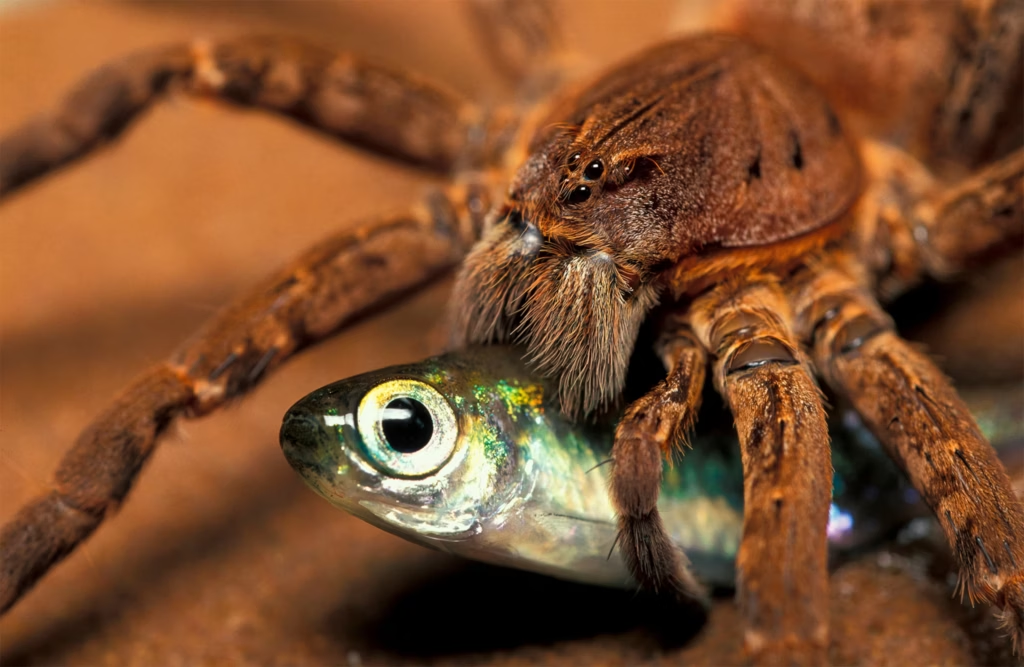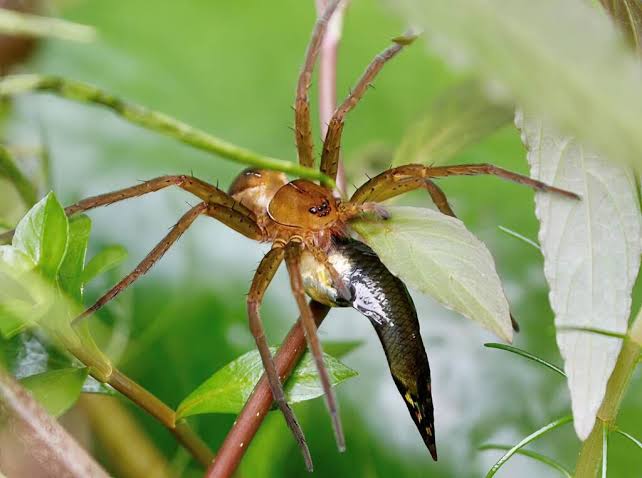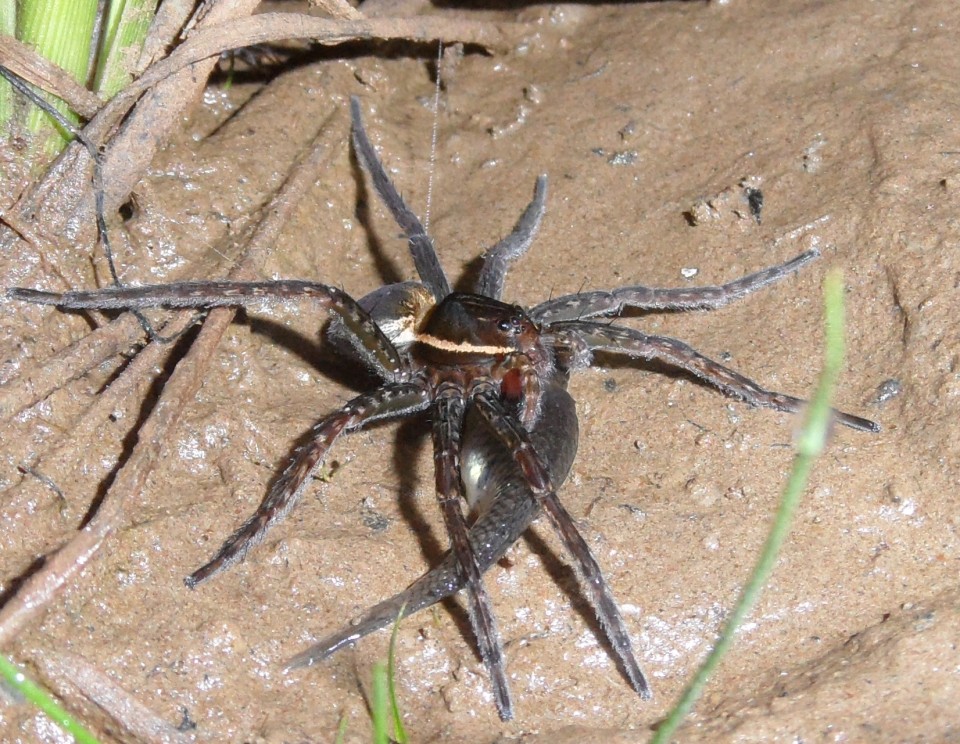Pisauridae—Nursery Web Spiders
Dolomedes tenebrosus
Fishing spiders, particularly those within the genus Dolomedes, bear a close resemblance in size, form, and coloration to the larger wolf spiders. These arachnids are colloquially known as “fishing spiders” due to their proclivity for aquatic environments, where they have been observed preying upon small fish and aquatic insects while traversing the water’s surface. However, Dolomedes tenebrosus is more commonly associated with forested landscapes and is more accurately characterized as an arboreal species. It frequently enters homes situated near wooded areas and ranges from New England and Canada southward to Florida and Texas.

Description
Dolomedes tenebrosus is a notably large spider. Adult females measure between 15 and 26 millimeters in body length, while males are more diminutive, ranging from 7 to 13 millimeters. Both sexes exhibit a brownish-gray coloration, accentuated with dark and light brown markings. Their legs display alternating bands—scalloped brown and black on the femora and reddish-brown and black on the tibiae. A closely related species, D. scriptus, shares a similar appearance but can be distinguished by the presence of distinctive white “W”-shaped markings on the posterior abdomen.
Life History
Unlike their aquatic relatives, D. tenebrosus is often encountered far from water, typically in dense woodlands. The species overwinters in its penultimate instar beneath stones, under loose bark, within tree cavities, or inside human structures, maturing in the spring. Adults are commonly seen from early May through September. Females produce egg sacs in June and carry them until the spiderlings are ready to emerge. These hatchlings, often numbering over 1,000, are protected in a nursery web spun by the female and may be observed from July through September.
Natural History and Behavior
Fishing spiders are among the largest spiders in North America, with females exceeding one inch in body length. Males are typically about half the size of females. In southern regions, individuals may reach even more impressive dimensions, making the fishing spider the largest spider species in many parts of the United States.
Named for their affinity to aquatic habitats, these spiders are often spotted near shallow bodies of water, where they “fish” for minnows and insects. Commonly referred to as dock or wharf spiders due to their habitat preferences, they have also been mistakenly dubbed “raft spiders”—a misnomer implying that they construct rafts to navigate water surfaces. In woodland environments far from aquatic settings, they are more aptly described as “tree spiders,” reflecting their terrestrial and arboreal habits.
Though frequently found indoors, particularly in homes near forests, Dolomedes tenebrosus poses no real threat to humans. Their appearance may startle residents, but their venom is not medically significant. A bite is comparable to a mild bee sting and typically only occurs if the spider is provoked or feels threatened.
Unlike typical web-building spiders, fishing spiders are active hunters. They employ ambush tactics, often waiting near the water’s edge with their front legs poised in the water. Sensitive hairs detect minute vibrations beneath the surface, alerting them to the presence of potential prey. Once an aquatic insect or fish draws near, the spider lunges with astonishing speed, capturing and envenomating its target.
Occasionally, they venture across the water’s surface, relying on surface tension to support their weight. When diving, the hydrophobic hairs on their body trap a thin film of air, enabling them to breathe underwater. Their book lungs, located beneath the abdomen, allow them to remain submerged until they secure a catch, after which they return to land to consume it. Remarkably, they emerge from the water completely dry, encased in a silvery sheen of air.

When subduing prey, the spider delivers a bite using its hollow chelicerae, injecting venom that simultaneously immobilizes the victim and begins the digestive process. This allows the spider to later ingest the liquefied tissue.
During my observation, I witnessed a fishing spider deftly extract small aquatic insects from the shallows and immediately draw them toward its mouthparts. Its reflexes were strikingly rapid. I also observed it leap nearly a foot in a single bound. Everything about the fishing spider—its agility, precision, and adaptability—is nothing short of extraordinary.
How to identify Fishing Spiders
Females grow between 15 and 26 mm in length, while males fall between 7 and 13 mm. Fishing spiders are typically brown and may display black and light-brown markings, with brown and black banded rings on the legs. Often confused with wolf spiders, fishing spiders can be distinguished by their large size and the position of their eyes, which are arranged in two horizontal rows of four. Some species display white abdominal markings that range in appearance from spots or speckles to W-shaped or chevron patterns.
Signs of an infestation
Fishing spiders commonly live in and around pools and can infiltrate homes. Possible signs of a fishing spider infestation include the moulted exoskeletons of the developing offspring, which are easily recognizable for their large size compared to other spider species. Living close to wooded areas increases the chances of seeing or otherwise encountering fishing spiders.

Fishing Spiders Removal
The removal of fishing spiders entails the cleaning of areas previously occupied by the pests. Getting rid of any woodpiles stacked around the house eliminates harbourage sites. Residents should also spend some time looking around basements and crawl spaces to remove the pests from the home. If a fishing spider infestation gets out of hand, call a local pest control service to combat the problem immediately.
How to prevent Fishing Spiders from invading
Limit the amount of standing water on the property around the home to reduce the availability of preferred food sources. As fishing spiders also enjoy the vegetation in and around standing bodies of water, limiting these ideal hiding places may result in a reduction of the arachnid population as well.
Habitat, Diet, and Life Cycle
Habitat
Some species of fishing spiders can be found away from bodies of water. However, the majority of species seek water to find prey. As the pests typically move from site to site, they frequently encounter humans. Whether living in the wild or near manmade bodies of water, fishing spiders look to vegetation for cover. These arachnids can also be found under rocks or wood.
Diet
Fishing spiders are classified as generalist predators and use ambush tactics to catch many types of prey unaware. Using the water to feel vibrations much like other spiders use webs, these semi-aquatic arachnids grab any kind of reasonably sized prey within reach. Many types of fishing spiders feed on insects, while larger species may catch small fish. The fishing spider diet also consists of tadpoles and small frogs.
Life Cycle
While they may not use silk webbing to entrap prey, fishing spiders manufacture silk to facilitate the hatching of their eggs. Female fishing spiders produce egg sacs filled with their offspring, wrap the eggs in the silk, and carry them between their fangs until hatching begins. Once hatching starts, the mother spider creates a nest with webbing to provide protection for the next generation. Hatchlings resemble full-grown adults and shed their exoskeletons over time as their bodies grow.
Commonly Asked Questions
Why do I have fishing spiders?
Fishing spiders, also called dock or wharf spiders, like to live in waterfront properties near lakes, ponds, marshes, reservoirs, rivers, streams, and woods. Swimming pools, boathouses, and boats may also become infested.
Able to feed on prey almost five times their size, fishing spiders have been reported to eat aquatic insects, minnows, tadpoles, frogs, and even small fish. When weaving their own tent-like nests – or nursery webs – they like to build in tall grasses, between rocks, or under docks.
How worried should I be about fishing spiders?
For many people, the size and fierce appearance of a fishing spider alone are enough to cause alarm and stress. fishing spiders can also bite when trapped inside clothing, held, or sat or stepped on. Whilst not fatal, the bites are painful, similar to bee stings.
These pests also reproduce at an alarming rate, laying up to 1,000 eggs at a time, so it is important to act quickly if you suspect an infestation and to contact a professional pest control service to remove these pests effectively.
